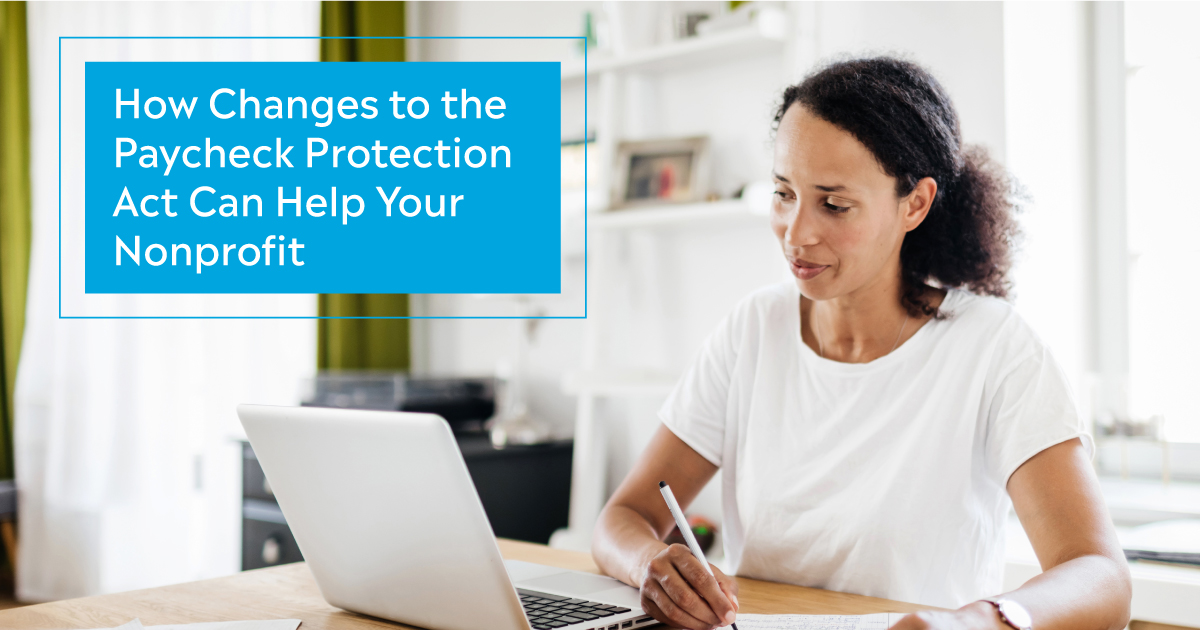Nonprofit Technology & Fundraising Blog
Subscribe to our mailing list
June 9, 2020 |

For those who received loans from the Coronavirus Aid, Relief, and Economic Security Act (H.R. 748 or the CARES Act), and the Paycheck Protection Program (PPP) in particular, there is a new piece of legislation that will help you maximize loan forgiveness.
It’s called the Paycheck Protection Program Flexibility Act of 2020 (PPPFA).
Here’s what you need to know about the new legislation:
As weeks turned into a month, and one month became three months, it became clear that the 8 weeks of forgiveness initially provided by the PPP was not going to be enough. Now, it isn’t just 8 weeks of expenses that are eligible for forgiveness, it’s 24 weeks (or through December 31, 2020 for those who have not yet applied for loan forgiveness yet.
Those who received loans before the PPPFA was enacted can choose to extend the 8-week period, or they can stick with the original timeline.
Under the PPP, loan forgiveness required 75% of the funds to be used for payroll costs. This was intended to encourage small organizations (including nonprofits) to keep employees on the payroll for as long as possible and minimize the financial hit to those families.
As forced closures extended to longer periods of time, it became impossible for many organizations to be able to do this, but the operational expenses to maintain facilities and pay rent, mortgages and other business loans didn’t go away.
The PPPFA reduces the 75% payroll cost requirement to 60% of the covered loan amount. The Treasury Department or Small Business Administration will issue additional information to clarify exactly how this will change the forgiveness calculation or whether the existing sliding scale will remain in effect.
Borrowers now have an extra six months to restore any reductions in salaries, hourly wages, or full-time equivalency levels. The deadline is now December 31, 2020 instead of June 30, 2020.
What does that mean? It means the pay cuts and reduced hours your dedicated employees had to agree to accept to help keep you in business can be restored to what they were pre-COVID-19 through the end of 2020, which can help you obtain the maximum amount of your PPP loan available for forgiveness.
The extension will not only help you retain your staff and restore their income, it can also help you reduce the amount of the PPP loan you’ll need to repay.
What if you can’t re-hire qualified staff or find replacement staff right away? The long layoff may have prompted some to look for other careers, You may encounter some trouble bringing staff back and achieving that 60% payroll cost requirement for PPP loan forgiveness. Also, you may not be able to bring in as much money as you were before the virus hit.
The PPPFA added exemptions regarding full-time equivalent (FTE) reductions in loan forgiveness if borrowers: a) are able to document an inability to re-hire or hire qualified employees, or b) are able to document an inability to return to the same level of business operations as of February 15, 2020 due to compliance with COVID-19 restrictions.
Section 2302 of the CARES Act allowed borrowers to defer the employer portion of Social Security taxes until such time as their PPP lender determined whether their loans were eligible for forgiveness. Now, the new PPPFA legislation allows any PPP borrower to defer employer Social Security taxes, regardless of whether their loans are forgiven. You’ll still need to make the lump sum payments in 2021 and 2022, but you can defer for the remainder of 2020 if you so choose.
The PPP loan program still has some funds available! You can view a list of participating lenders here.
For more information about the PPP, learn about how the CARES Act and the PPP program can help nonprofits and check out the results of a CARES Act Survey DonorPerfect conducted of more than 750 nonprofits.
The experts at DonorPerfect and special guest authors have created a series of free resources for nonprofits facing new challenges during the COVID-19 pandemic. Check out the Free COVID-19 Resources for Nonprofits section of our blog for more useful strategies.
Follow us on social!